Shalom Staub named director of UCLA Center for Community Learning
Following a national search, Shalom Staub has been selected as director of the UCLA Center for Community Learning, effective September 1.
Following a national search, Shalom Staub has been selected as director of the UCLA Center for Community Learning, effective September 1.
The American Talent Initiative (ATI) and the Campaign for College Opportunity have both recognized UCLA for its dedication to helping community college students transfer to and graduate from four-year universities.
Douglas Yao discovered his passion for research as an undergraduate at UCLA. Now, he’s embarking on a PhD at Harvard in pursuit of his goal to run his own lab in the field of bioinformatics.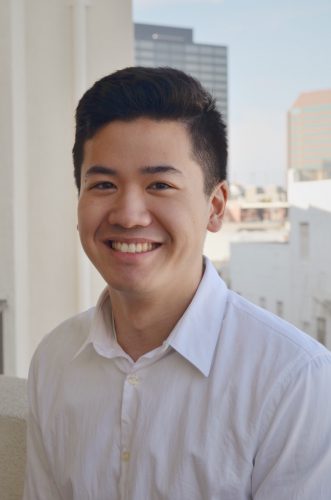
Yao, who graduated in June with a bachelor of science in cell/cellular and molecular biology, said he entered UCLA as a pre-med and first began working in labs on campus during his freshman year in order to prepare for applying to medical school. But he found that he enjoyed spending time in the lab so much that he wanted to make research his career.
Yao worked in four different labs throughout his undergraduate career as he attempted to hone in on which research topics he was most interested in. Ultimately, the labs of Thomas Graeber, professor of molecular and medical pharmacology, and Eleazar Eskin, assistant professor of computer science and human genetics, sparked his newfound passion for a field called bioinformatics, in which scientists collect and analyze biological data.
“Bioinformatics brings together three disparate fields: biology, computer science and statistics,” Yao said. “I saw that as a good opportunity because there has to be a breed of scientist who knows all three subjects.”
Yao presented his original research projects twice at Undergraduate Research Week and currently has a paper in review, about gene expression and genomic instability in cancer cells.
This summer, Yao began his first year in Harvard’s bioinformatics and integrative genomics PhD program. He hopes to become a professor and run his own lab one day, a goal that he acknowledges would be much harder to reach if he hadn’t gotten his start at UCLA. He’s seen how valuable the undergraduate research opportunities are at UCLA, and how they inspired and prepared him for his career ahead.
“If you don’t go to a big research school it’s so much harder to get those research experiences,” Yao said. “I was really lucky to have picked UCLA because of the research environment.”
The opportunity to conduct his own research not only taught him new skills such as how to analyze research papers and participate in scientific discussions, but also introduced him to the world of being a professional academic and researcher. He realized how much he loved learning.
“I don’t think there are a whole lot of careers that let you consistently learn every single day,” he said. “There’s so many interesting things out there in the world and we know so little. I think [research will] help me appreciate just how weird and amazing the world is.”
As UCLA undergraduate Jendalyn Coulter spoke to the several dozen professors, students and educational leaders about her research on former foster youth who go on to college, she was poised and commanded the room.
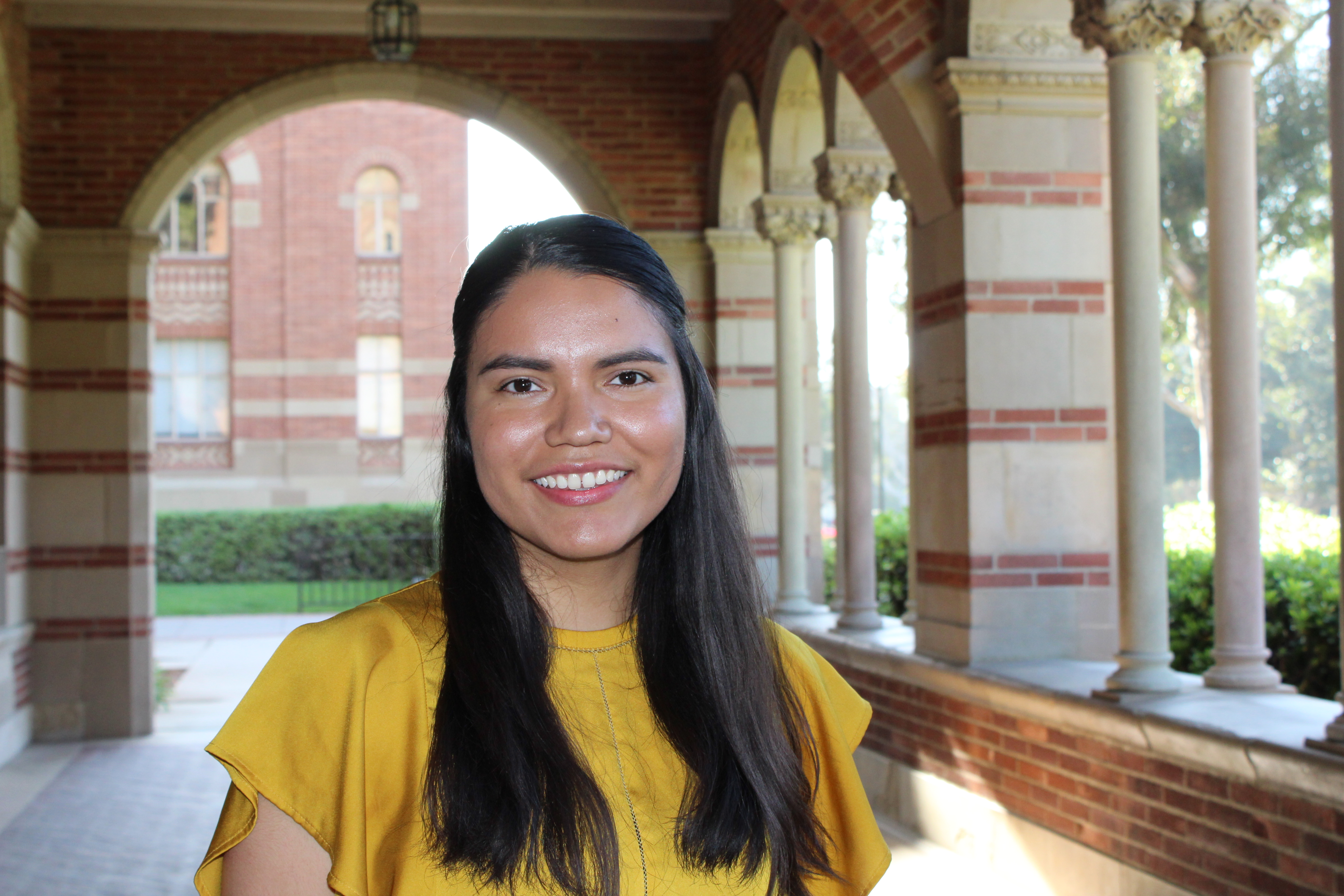
Rocio Sanchez-Nolasco. Photo by Chloe Hourdequin
Fourth-year art history major and digital humanities minor Rocio Sanchez-Nolasco is about to have her original research published by a southern California art gallery, all because of a photo her proud professor shared on Facebook.
Sanchez-Nolasco will write a total of six essays about photographs taken by artist Patssi Valdez that will be published on the internet-based Sanguine Gallery’s website every other month beginning in September. In her writing, she intends to discuss the historical, social and cultural contexts of Valdez’s work and analyze the photographs’ portrayal of Chicana femininity.
Charlene Villaseñor Black, professor of Chicana/Chicano studies and art history, is Sanchez-Nolasco’s honors thesis advisor. For the past year, the two have met weekly to discuss Sanchez-Nolasco’s interests and hone in on a research topic for her thesis.
After becoming interested in Asco, an East Los Angeles Chicano artist collective during the 1970s and ‘80s, and doing research at the UCLA Chicano Studies Research Center, Sanchez-Nolasco stumbled upon photographs by Valdez, a founding member of Asco who is more well-known for her brightly-colored, avant-garde expressionist paintings. She decided to make Valdez’s photography the subject of her thesis.
“I was blown away that she identified this as a topic that needed to be researched,” Black said. “No one has written about [Valdez’s photographs]. It’s a completely new topic.”
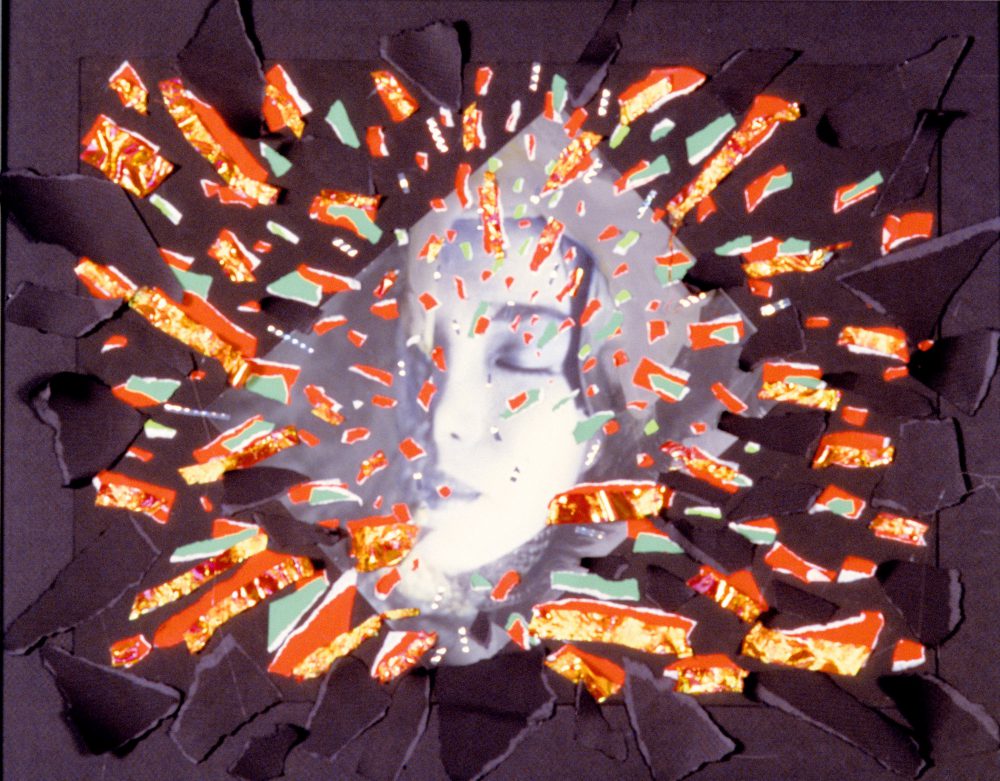
Patssi Valdez, “Pyrah.” 1980s, mixed media photo collage. Courtesy Patssi Valdez
Sanchez-Nolasco admired the photographs’ distinctive style and was surprised no one had examined them on their own, not just within the context of Valdez’s other work.
“I thought all these images were so beautiful and so amazing that I couldn’t think of a reason why no one has written about them collectively,” Sanchez-Nolasco said.
Sanchez-Nolasco presented a poster about her preliminary research findings at Undergraduate Research Week this May. Black was so proud of her and all her undergraduate advisees that she posted pictures of them on Facebook, including captions about their accomplishments and projects.
To her surprise, later that day, her picture of Sanchez-Nolasco standing in front of her poster at Undergraduate Research Week received a comment from Thomas Canavan, arts administrator of the Sanguine Gallery and creative arts and special projects manager of the Millard Sheets Arts Center in Pomona, Calif. Black met Canavan recently after she participated in a talk at Millard Sheets.
“Is it possible to get a copy? We’d love to publish it!” Canavan wrote, referring to Sanchez-Nolasco’s poster about Valdez.
As it turned out, the Sanguine Gallery was about to launch a Valdez exhibition, and the gallery frequently publishes writing and other creative works on its website to accompany its physical exhibits. Sanchez-Nolasco’s research would be the perfect accompaniment to the Valdez exhibit.
Canavan said the Sanguine Gallery wants to provide a space for artists, creators and scholars of all ages and experience levels to contribute their voices and unique insights – even an undergraduate like Sanchez-Nolasco. It benefits everyone, Canavan said, since young scholars in particular may be more connected to certain cultural and artistic spaces that older people may not.
“We exclude younger voices and because of that, they don’t have the opportunity to express what they think,” Canavan said. “If we’re not listening to them, we’re missing out on an opportunity to learn more about what’s around us.”
Sanchez-Nolasco credits Black for supporting her research and for making her partnership with the Sanguine Gallery possible.
“I just thought my project would be a thesis and that would be the end of it, but it’s really a privilege and an opportunity to be able to share my research in this way,” she said. “It’s inspiring to see that this is an opportunity I can now pursue as an undergraduate student.”
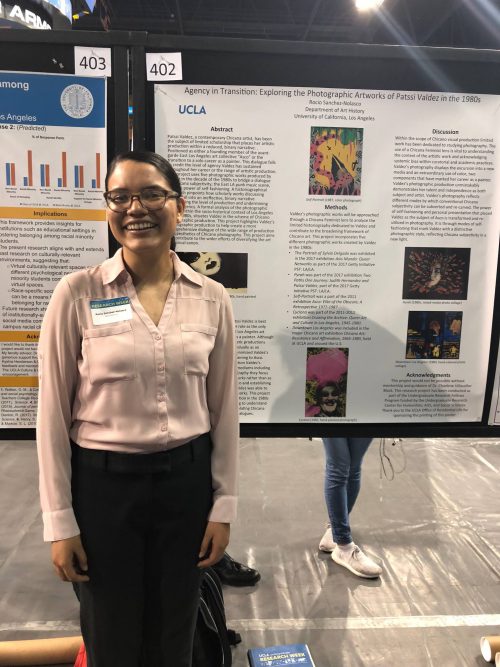
The photo that Black shared on Facebook.
Two UCLA College honors students presented at the annual Academic Resource Conference sponsored by the Western Association of Schools and Colleges (WASC) Senior College and University Commission.
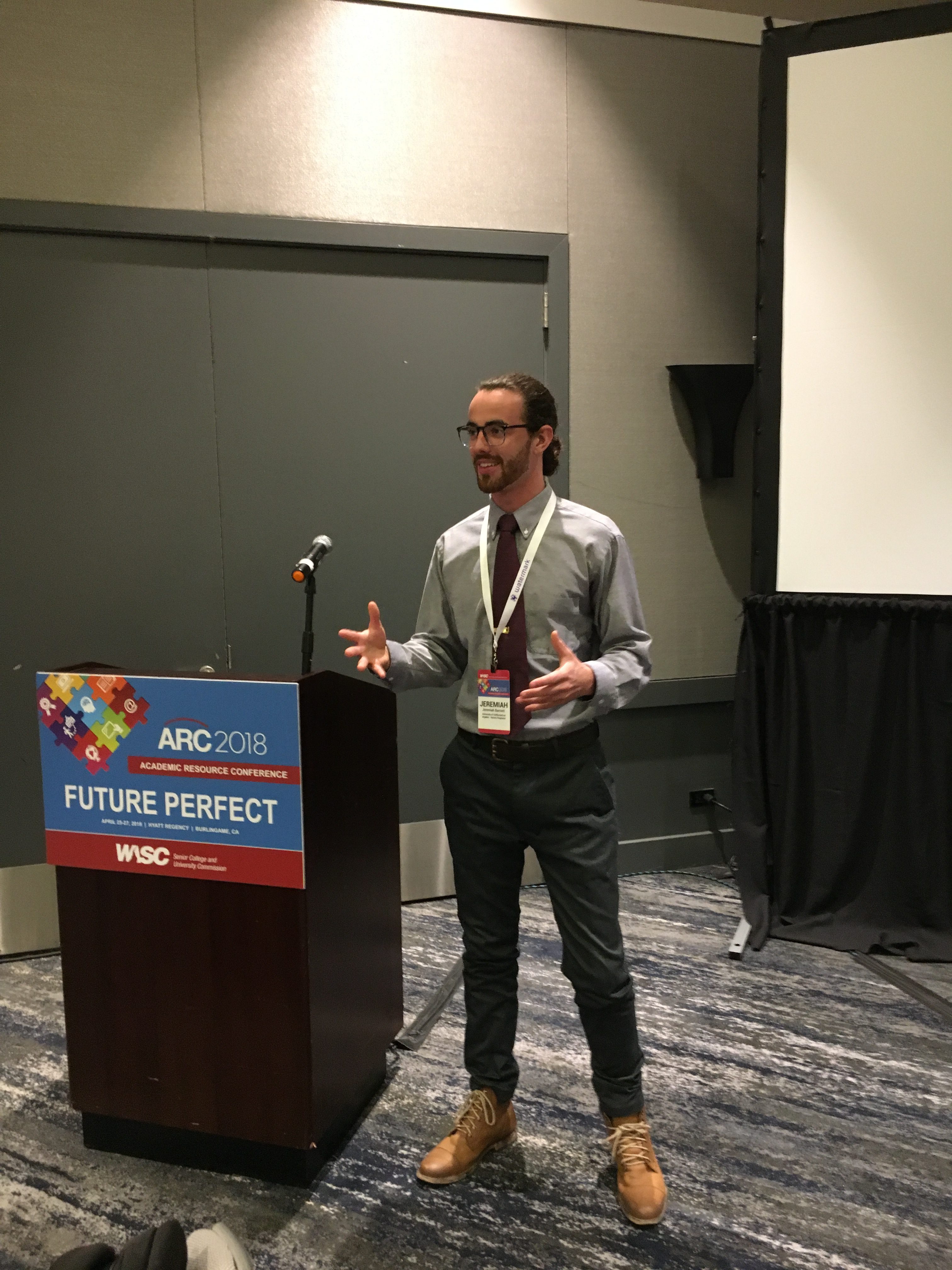
Jeremiah Barnett giving his presentation at the ARC.
Held in April in Burlingame, Calif., this year’s conference theme was “Future Perfect,” and focused on encouraging university faculty, administrators and staff attendees to exchange ideas about how to transform their schools to meet the opportunities and challenges of the future.
Third-year neuroscience and African American studies double major Chinyere Nwonye and fourth-year political science major Jeremiah Barnett joined Jennifer Lindholm, Assistant Vice Provost of Undergraduate Education and Director of Honors Programs at UCLA, in a presentation about the newly redesigned College Honors Program titled “Learning, Being, and Doing: Launching a New College Honors Program.”
In another session facilitated by Director of Assessment Kelly Wahl and Director of Curricular Initiatives Mitsue Yokota, both of the UCLA Division of Undergraduate Education, Barnett offered his insights into learning outcomes and interests.
Lindholm noted that Nwonye and Barnett, both Honors Fellows, were invited to speak because of their valuable contributions toward enriching UCLA’s traditional College Honors Program and developing the new pilot program, which will welcome its inaugural cohort of first-year students this fall.
During the group’s 15-minute presentation, Nwonye and Barnett each shared their personal experiences as honors students in order to explain how the honors program was transformed to be more experiential and interdisciplinary, more tailored to students’ individual interests, and better positioned to cultivate a community among honors students.
“I was thrilled, humbled, honored and of course nervous,” Barnett said of being invited to speak at the conference. “But I was excited to be able to share my story.”
Barnett spoke about his expectations on entering the honors program compared to what he felt he ultimately gained from the program. He stressed the importance of discussing learning outcomes with students. Nwonye talked about experiential learning and how it has enriched her academic career.
Lindholm said that student participation in these meetings is essential as it allows conference attendees to hear directly from students and ask them questions about how to get students to be more connected to university programs.
“We do a lot of talking about students and how to document ‘evidence’ of their learning such that federal expectations for institutional effectiveness are satisfied,” she said. “Too often though, we don’t invest enough time actually talking with students and, especially, listening closely to what they have to say. When we do, the conversations are more fun and good ‘outcomes’ tend to result for all involved.”
Nwonye said, “The [attendees] were very interested especially because Jeremiah and I were there and [we could explain] how students become more engaged and how we’re going to do that [in the honors program].”
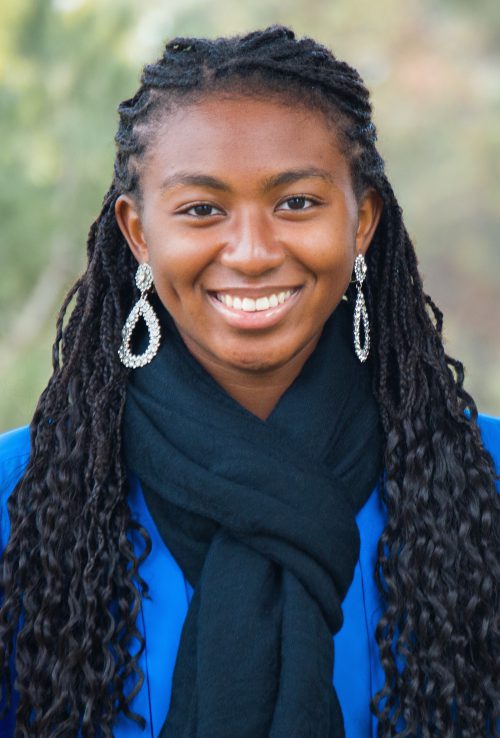
Chinyere Nwonye
Barnett said he thought the support of the UCLA administrators added to the audience’s enthusiasm and interest in the presentation.
“Being backed by the [attendees’] peers from UCLA gave us, as students, a level of credibility that allowed us to speak and others to listen,” Barnett said.
Nwonye and Barnett hope that more students might be invited to participate at similar conferences in future, noting that they offer a valuable real-world perspective that administrators and staff don’t often hear, and that inviting students to contribute to the conversation can impact
the decisions made by university leaders.
“I felt like I was representing my peers who don’t have the opportunity to speak in front of people, to help make decisions that may impact students’ lives,” Barnett said.
“Jeremiah and Chinyere did a fantastic job representing UCLA and our honors program,” Lindholm said. “Their valuable perspectives, coupled with their poise, candor and enthusiasm, made them the stars of every session in which they participated.”
Hundreds of videos, interviews, photos, articles and other resources related to the life of tennis legend and UCLA alumnus Arthur Ashe are now accessible via the Ralph J. Bunche Center at UCLA on its new Arthur Ashe Legacy website.
Friday, June 15, 1 p.m. It’s College Commencement Day at UCLA and one of the biggest ceremonies of the year is about to start.
Across campus, families and graduates take photos at Bruin Bear, buy flowers and decide on meeting spots. As the graduates say goodbye and line up on the LATC South Tennis Courts, preparing for their big entrance into Pauley Pavilion, families make their way into the arena, where they survey the crowds of people already packed into the stands, trying to figure out where they’ll have the best view of their graduate.
Inside Pauley Pavilion Club, another group is gathering: the UCLA faculty and student speakers who will lead the ceremony. Here, faculty put on their commencement robes and get into position for their march down the center aisle of Pauley Pavilion’s John Wooden Court to the stage after the graduates have been seated.
For the faculty, commencement isn’t a once in a lifetime experience – it’s an annual one, a ritual they participate in every year to honor their graduating students. Yet in the hour leading up to the ceremony, they are as excited as the graduates marching into Pauley Pavilion, eager to celebrate the Class of 2018 and start bringing another academic year to a close.
Read on for a behind-the-scenes peek backstage at UCLA College Commencement’s 2 p.m. ceremony.
1:00 p.m. College staff volunteers arrive and begin their assignments. Volunteers help set up food, pin hoods to faculty gowns, organize programs and more to make sure the ceremony runs smoothly.
1:17 p.m.: Faculty begin to arrive and get dressed in their commencement robes, with the help of staff volunteers.
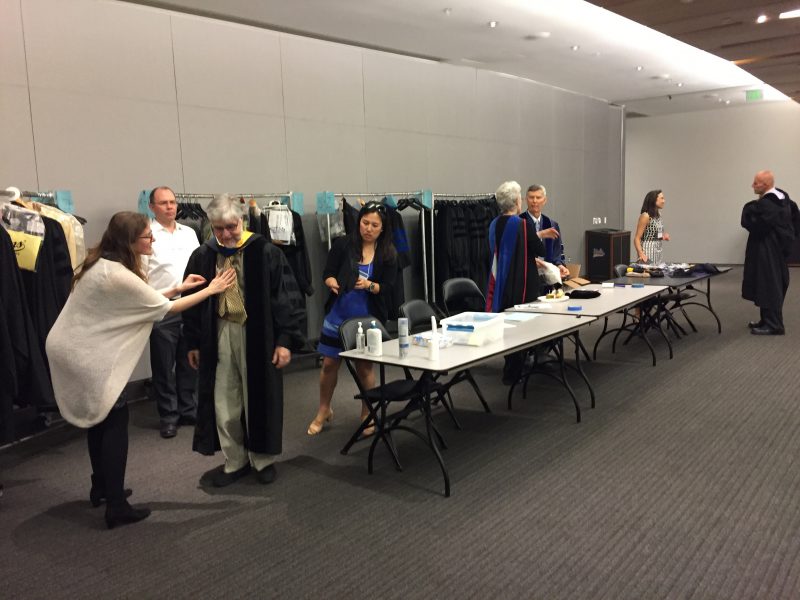
1:29 p.m.: A professor compliments her colleague’s matching red robes: “You look like you graduated from the same place I did!”
1:36 p.m.: Faculty chat about their summer plans.
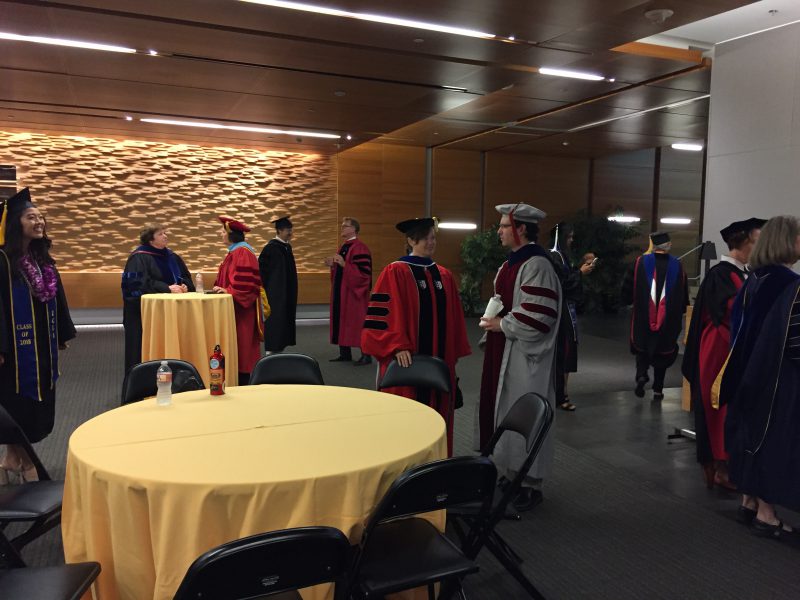
1:37 p.m.: Chancellor Gene Block arrives.
1:40 p.m.: Faculty begin finding their places in the lineup. Chairs are labeled with the names of each member of the faculty and students who will have a speaking role in the ceremony in the order in which they will walk out so they end up in the correct seat onstage. For those who will not be speaking, signs indicate where each College division should gather so they are seated together onstage.
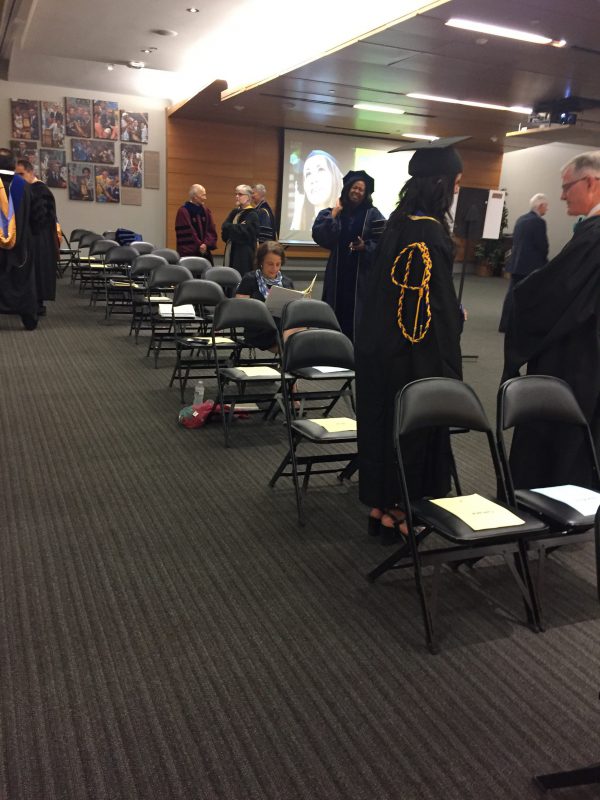
1:49 p.m.: Members of the VIP party – Carol Block and special guests of the stage party – are escorted out to their seats in Pauley Pavilion as the graduates begin the procession.
1:51 p.m.: A professor takes a grinning selfie of himself in his robes.
1:52 p.m.: Chancellor Block takes photos with several faculty members and the student speakers.
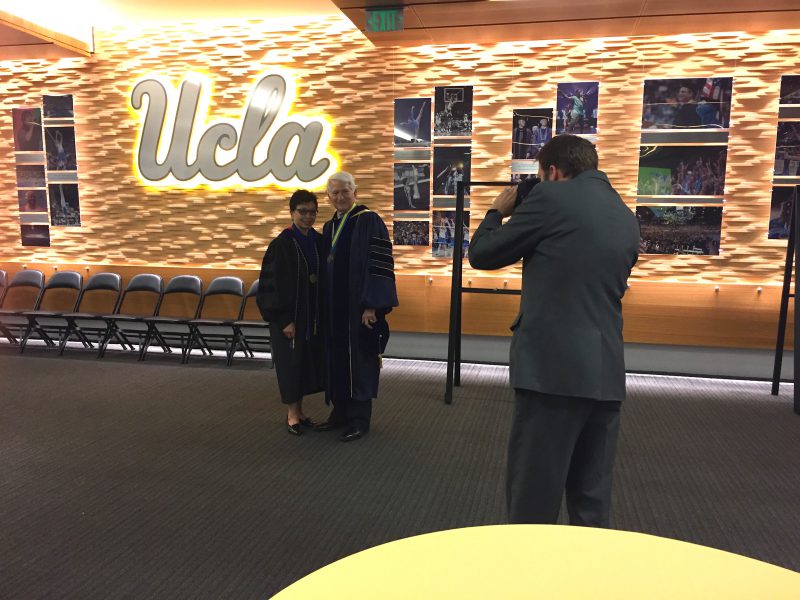
1:55 p.m.: An announcement is made about a change to the seating procedures, prompting laughter and jokes around the room about how well the faculty will remember what to do.
2:04 p.m.: Watching a live feed of the graduates entering Pauley Pavilion, student vocalist Ritu Sreenivasan exclaims, “Wow, that’s so cool! I’m gonna cry.”
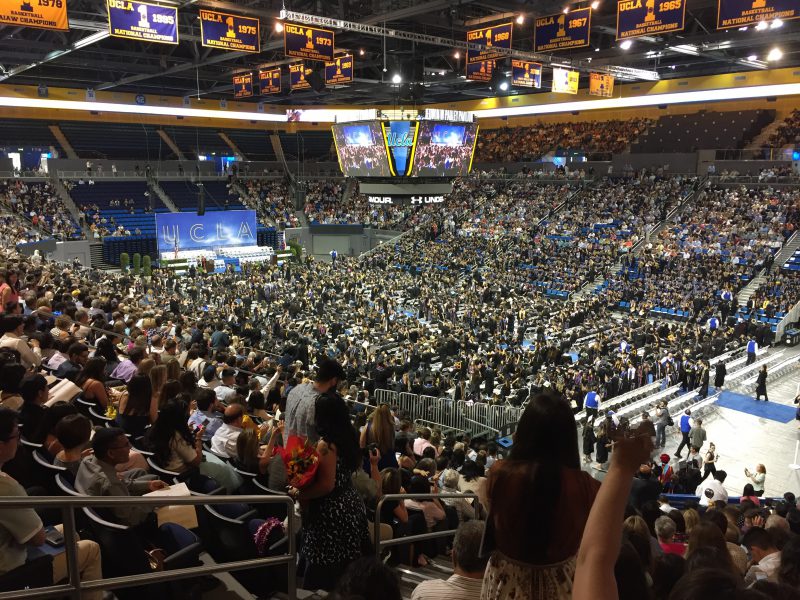
2:06 p.m.: Dean Patricia A. Turner greets Sreenivasan and student speaker Emily Yamane, who says, “I’m so nervous!” Dean Turner assures her, “You’ll be fine.”
2:08 p.m.: The faculty gather at their assigned seats or with their division to prepare for the processional.
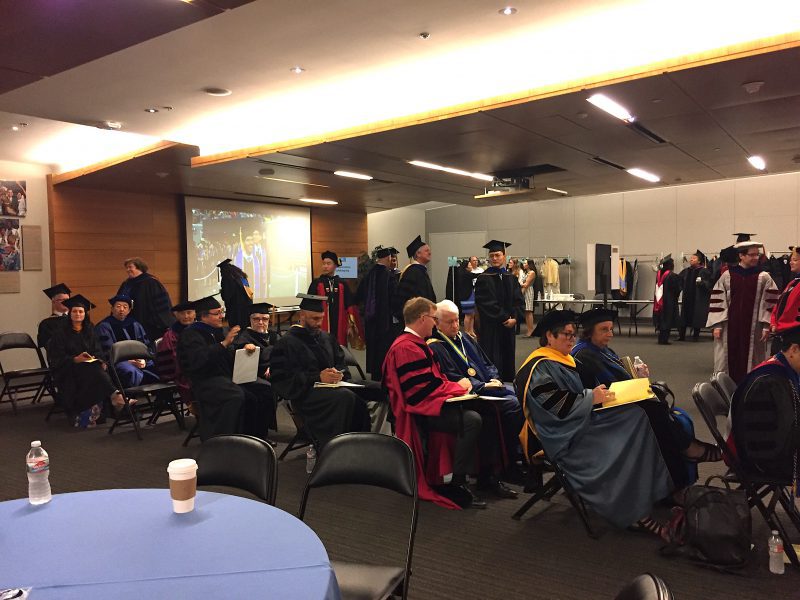
2:16 p.m.: The faculty stand and line up, ready to walk out.
2:18 p.m.: Faculty are told they will have to wait a few more minutes because the graduates are backed up getting into Pauley Pavilion.
2:22 p.m.: Professors and students pose for pictures with each other as they wait.
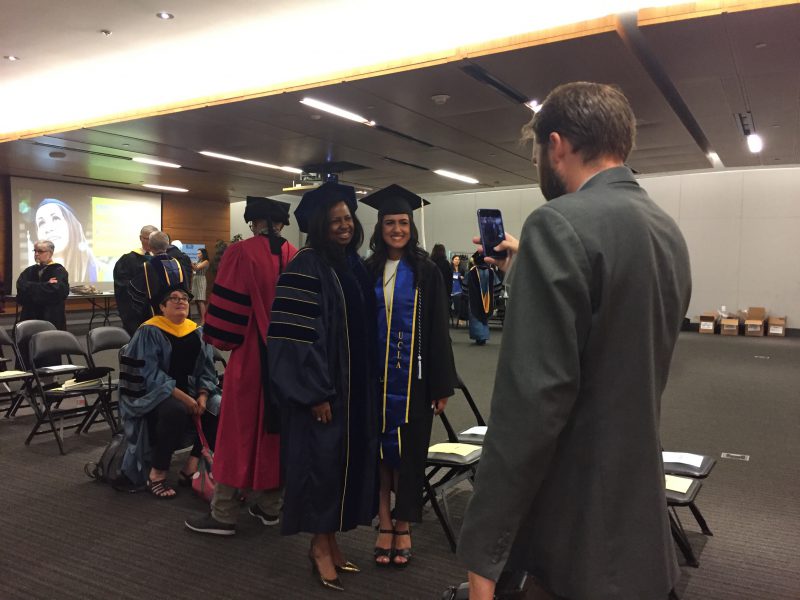
2:24 p.m.: The faculty are led down to the stage of Pauley Pavilion!
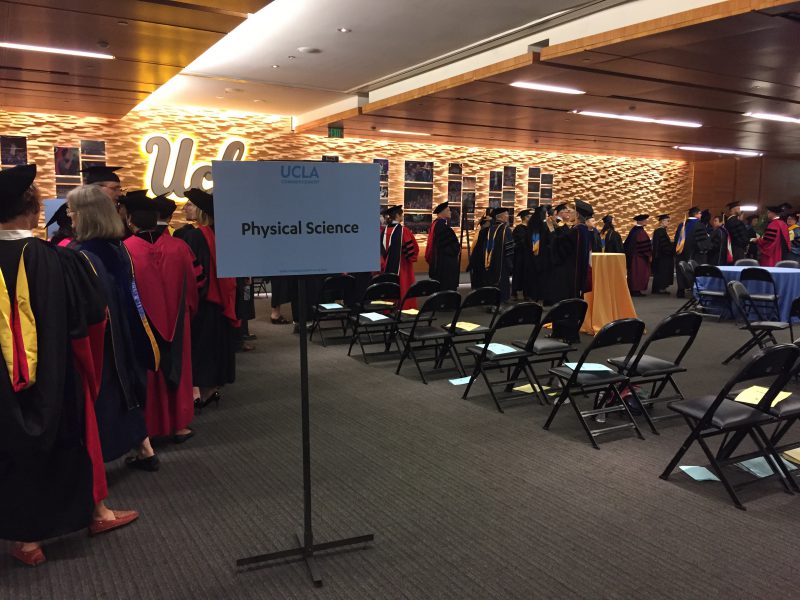
Professors Gregory Pottie, Kara Cooney and Alvaro Sagasti share why they support undergraduate research and why they find Undergraduate Research Week so impressive.
Undergraduate Research Week showcases and celebrates undergraduate research and creative projects across disciplines. Open to undergraduate students in all majors, the week provides opportunities for students to present their work to the UCLA campus community, alumni, and visitors. In the first four years of holding the event, participation has grown to over 1,000 student participants.
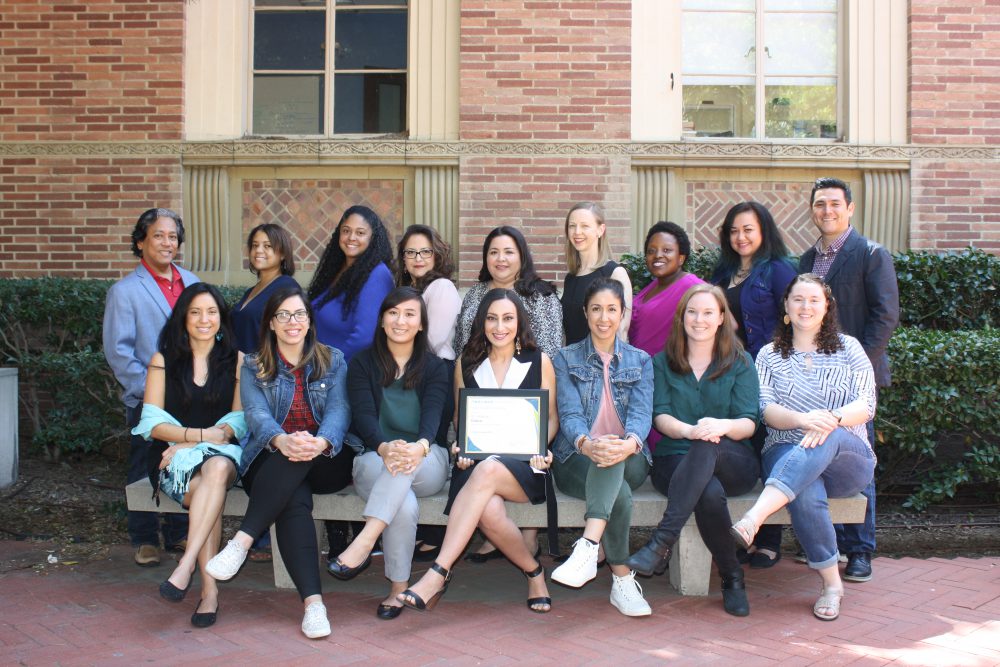
Marian Gabra, center, with the ACE Committee
Twice per quarter, around 50 staff from across UCLA gather at interactive workshops to discuss best practices, tools, and theory about the work they do every day: advising students.
The workshops are part of College Academic Counseling’s Advising Communities of Excellence (ACE) Professional Development Program. Combining workshops and smaller learning communities, ACE is a unique blend of scholarship, community-building, and professional development that, only in its second year, is already gaining recognition as one of the most significant professional development programs for college advisors in the country.
Marian Gabra, director of advising professional development, created ACE from the ground up in 2016, under the direction of Assistant Vice Provost for Undergraduate Academic Support Corey Hollis. Inspired by a growing movement across the advising profession toward professional development in order to achieve greater student success, Hollis tasked Gabra with building a professional development program for advisors at UCLA.
“The goal is to get us all on the same page, speaking the same language, and supporting students in a very intentional way and in a way that’s very collaborative and cohesive,” Gabra said.
Gabra leads ACE’s committee of 20 volunteer members representing the College of Letters and Science and departmental advisors, the Schools, and the Division of Student Affairs.
“Building community, practicing theory, and theorizing practice”
The ACE program includes bi-quarterly interactive workshops, each one focusing a different topic, such as “Fostering Resilience in Students and Ourselves,” “Advising Approaches and Theories,” and “Supporting First-Generation Students.” Workshops include readings of scholarship and theory, a brief presentation about the topic, and discussion of scenarios and case studies. At the end of the workshop, each participant formulates an action plan for how they will incorporate what they’ve learned into their own practice.
Workshops are open to all staff campus-wide as well as graduate students if space allows. Each workshop typically sees around 50 attendees on average, and they represent a wide range of advisors, from academics to the Career Center, from Residential Life to financial aid – any staff member who advises students is encouraged to attend.
Staff can join smaller ACE learning communities through the ACE Reads Study Group Program, which focus on specific topics, such as wellness, UC basic needs, and leadership and management. Each study group is expected to produce a deliverable at the end of the academic year, such as a published paper or presentation. ACE has partnered with UCLA Librarians to develop a seven-workshop series that will launch this summer and extend throughout the next academic year. This series will support advisors who wish to learn more about conducting their own academic research within the field of advising.
The ACE mentoring program also provides additional support and mentorship opportunities for campus professionals.
With the tagline “Building community, practicing theory, and theorizing practice,” ACE is not merely a training course, Gabra said.
“What sets ACE apart from other professional development programs is our desire to participate and engage with theory, whether that’s to become more scholarly advisors or to be scholar-practitioners,” Gabra said. “The fact that we’re providing the support through librarians and in partnership with faculty is really going to help propel this program forward and [position] UCLA advising as the frontrunners in the country.”
Making an impact at UCLA and beyond
The national advising community has already taken note of ACE. In March, Gabra and the ACE program won the Excellence in Advising Innovation Award from the National Academic Advising Association (NACADA) Region 9, which represents California, Nevada and Hawaii. At last year’s Advising Research Symposium hosted by ACE, the Director of NACADA’s Center for Advising Research, Wendy Troxel, said that while many universities want to have a program like ACE, UCLA is the first to really make it happen.
Shahla Rahimzadeh, academic advisor in the College of Letters and Science and a member of the ACE committee, said that ACE empowers her and her colleagues by validating their efforts and recognizing the importance of their work. And, it’s made her a better advisor to her students.
“If we can work on ourselves, self-reflect, and [focus on] our own development, I think in turn that has an impact on what we do with students,” Rahimzadeh said.
Janel Munguia, undergraduate counselor in the English department and advisor of the minor in entrepreneurship, agreed that when advisors can learn from each other and share ideas about their work, it is beneficial both for the advisors and their students.
“ACE provides a forum for both individual growth of each academic advisor, as well as the growth and strengthening of our relationships with each other as part of a cohesive community,” Mungui said. “ACE gives us this gift of time with each other.”
Gabra hopes ACE fosters enthusiasm towards advising at UCLA and inspires in the advisors a sense of pride for the work they do, which will ultimately benefit the students most of all.
“Advisors aren’t just here to tell students what classes to take, but to work with students to collaborate with them, partner with them, and create a more meaningful experience for them,” she said. “If I’m asking students the right questions and supporting them and encouraging them to realize their dreams and working with them to create a strategic plan, to get where they want to go, then they’re going to do so much better.”
